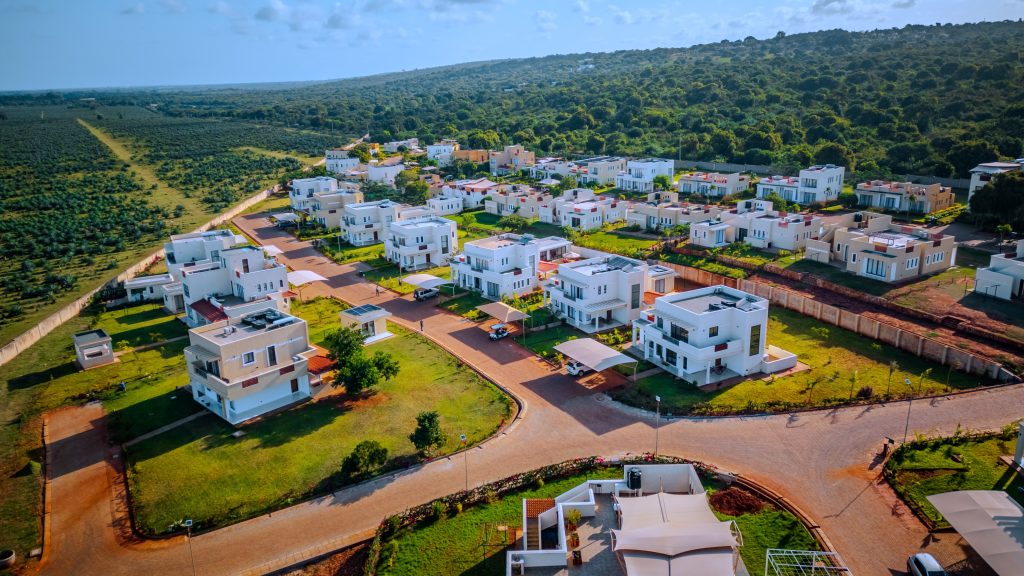Kenya’s real estate market is buzzing with activity, exhibiting dynamic trends that are reshaping investment landscapes and offering opportunities across various regions.
A closer look reveals that satellite towns and emerging hubs are leading the charge, fueled by a potent mix of affordability, significant infrastructure development, and the rise of strategically planned mixed-use projects.
For years, the appreciation of land prices in Nairobi’s satellite towns has been a consistent storyline, and it continues to be the dominant trend. Areas such as Juja, Ruiru, Kikuyu, Ngong, and those stretching along the Eastern Bypass are becoming increasingly attractive.
Their allure lies in their relative affordability compared to Nairobi’s city centre, coupled with ongoing government investments in infrastructure like bypasses and expressways that drastically improve connectivity and ease of access. This makes them prime targets for individuals looking to build their homes just outside the bustling city.
While many suburban regions have seen stable land prices, some notable exceptions are Kileleshwa and Hurlingham, which have recorded impressive growth rates of approximately 11% and 6% respectively. This indicates a sustained demand and ripe development potential within these more established, yet still evolving, suburban pockets.
For investors seeking high returns on their developments, certain areas are emerging as clear frontrunners. Rosslyn, for instance, has been a standout performer, registering an astounding 40% growth in under two years. Mirema isn’t far behind, showing a solid 20% growth in the same period. Other affordable regions promising high Return on Investment (ROI) include Kabete, Ruiru, Tigoni, and Mtwapa, offering compelling value for both residential and commercial ventures.
The pace of appreciation in some areas is remarkable. Nakuru has seen a 20% growth in less than two years, cementing its status as an increasingly popular destination. Tigoni takes the spotlight with 80% growth in just two years, signaling its rapid transformation and escalating demand. Redhill is another fast-developing area with strong growth potential, while Runda has also delivered 20% growth in 1.5 years.
Conversely, the top 10 most expensive areas in Nairobi have remained remarkably consistent. These include Nairobi CBD, Eastleigh, South B, Brookside, South C, Upperhill, Hurlingham, Parklands, Kileleshwa, and General Mathenge. Their sustained high values are primarily attributed to strategic locations and persistent demand for both residential and commercial properties, particularly those in close proximity to the Nairobi CBD. For example, land in Upperhill can fetch as much as KSh 522.7 million per acre.
A significant game-changer in the Kenyan land market has been the advent of transformative mixed-use developments. Projects like Tatu City and Tilisi are not just building communities; they are actively driving land value appreciation in their surrounding vicinities.
Tatu City, located in Ruiru, has sparked a development boom. Areas like Kamiti Corner, near Tatu City, have seen land prices skyrocket to approximately KSh 60 million an acre, an almost 800% increase over 12 years (averaging 21% year-on-year growth). Similarly, Tilisi, a major mixed-use development along Limuru Road, has led to land prices upwards of KSh 30 million per acre in nearby gated communities, affecting areas like Rironi.
These developments introduce modern amenities, enhanced security, and crucial infrastructure like schools, parks, and retail spaces, all contributing to increased demand and significant property value appreciation.
Why the Coast is Kenya’s New Real Estate Gem

Beyond the Nairobi environs, the Kenyan Coast, traditionally a tourism powerhouse, is steadily gaining recognition as a real estate investment hotspot. Gradual increases in land prices are being observed, spurred by ongoing infrastructure development (such as the Dongo Kundu bypass and the Mombasa Gate bridge), a growing demand for vacation homes, and a robust rebound in the tourism sector.
While Diani Beach remains a premium market with high demand and surging prices (up to 20-25% in prime locations), other coastal towns like Watamu, Malindi, and Kilifi are emerging as attractive alternatives. These areas offer lower entry costs, promising renovation opportunities, and strategic infrastructural advantages.
For over two decades, Superior Homes Kenya has been a trailblazer in the country’s real estate sector, known for its commitment to large-scale, master-planned communities. While their flagship Green Park Estate in Athi River stands as a testament to this vision, the company has strategically expanded its footprint, including a significant venture in Kilifi’s Vipingo Ridge, signaling a growing interest in the coastal real estate boom.
“We bought land from Vipingo Ridge, 105 acres. We are doing 250 units there,” Ian Henderson, Superior Homes’ Managing Director, said during an interview with The Kenyan Wallstreet.
“This development maintains a similar spacious density to Green Park, offering a mix of holiday homes, second homes, and primary residences.”
“The move to Kilifi aligns with evolving buyer preferences. As Mombasa and Nyali become more congested, people are increasingly willing to move further out for a better quality of life and more space. The allure of having a “place at the coast” coupled with Superior Homes’ proven model of creating attractive, sustainable communities has made the Vipingo development “quite popular.”
Areas like Mtwapa, and Bamburi are proving particularly attractive due to the surge in short-term rental demand, promising strong rental yields for investors. Notably, beachfront properties in Nyali can command prices as high as KSh 100 million per unimproved acre.

